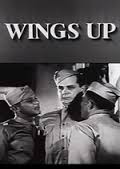
Summary
Wings Up (also known as Sustineo Alas in its release for the United States Army) is a short propaganda film produced during World War II, highlighting the role of the United States Army Air Forces Officer Candidate School. The film emphasized that while usually these courses would take up to a year in college, the country was at war now and needed all the qualified officers it could get and fast. The curriculum is briefly outlined in Wings Up as well as the kind of life a student would lead at this training center.
| Wings Up | |
|---|---|
 Media cover | |
| Starring | |
| Narrated by | Capt. Clark Gable (as credited) |
Production company | |
| Distributed by | Office of War Information, Bureau of Motion Pictures |
Release date |
|
Running time | 20 minutes |
| Country | United States |
| Language | English |
Plot edit
In 1943, a bombing mission by a Boeing B-17 Flying Fortress that had successfully dropped its bombs on target, has degenerated into an emergency situation over the Pacific. The navigator on board has not been able to plot a course back to the bomber's home base. The lives of the crew and the loss of the bomber depends on the skill and training provided for the navigator who represents a "weak link" in the crew.
The one solution to a lack of readiness to go to war in the air is the selection, testing, training and preparation offered by the Army Air Forces Officer Candidate School found in Miami, Florida. The motto of the school is Sustineo Alas (translated as "I sustain the wings"). The selection and testing to qualify is rigorous; after a physical examination, test scores based on general knowledge, and a stint as a corporal in command of soldiers, only 23 out of 1,000 candidates are chosen to proceed to the Officer's Candidate School.
All of the candidates have a diverse background and experiences, some as entertainers such as Robert Preston, while others have been successful in sports, business, science and academia. Many have also had combat experience as well as leadership positions. The twelve-week course stresses discipline, efficiency and restrictions that combine to instil all the attitudes and ethos of the officer cadre.
Cast edit
- Clark Gable
- Robert Preston
- General Henry H. "Hap" Arnold
- Gilbert Roland (uncredited)
- William Holden (uncredited)
- Brenda Marshall (uncredited)
Production edit
Narrated by Captain Clark Gable, Wings Up informed the youth of America about the Officer Candidate School, which was the primary setting for the production. [Note 1] In 1942, following the death of his wife, Carole Lombard, Gable joined the U.S. Army Air Forces after the Commanding General of the U.S. Army Air Forces Henry H. "Hap" Arnold offered Gable a "special assignment" in aerial gunnery.[1]
Gable entered USAAF OCS Class 42-E on 17 August 1942, completing training on 28 October 1942. Commissioned as second lieutenants, Gable's special assignment was to make a recruiting film in combat with the Eighth Air Force to recruit aerial gunners.[1] Gable had completed his training as an aerial gunner at the end of January 1943 and was promoted to Captain.[2] After the earlier film, Combat America (1943), Gable went to work on Wings Up, recreating much of the training he had gone through. The film ends with a graduation parade attended by General "Hap" Arnold and actress Brenda Marshall.[citation needed]
Stock footage of a Boeing B-17E Flying Fortress is featured in the opening and closing sequences of Wings Up.[3]
Reception edit
Wings Up was typical of the training and recruitment films of the period produced under the auspices of the Office of War Information.[4]
References edit
Notes edit
- ^ Gable appears on screen at the end of the film.
Citations edit
- ^ a b Argoratus, Steven. "Clark Gable in the 8th Air Force." Air Power History, Spring 1999. Retrieved: 23 January 2017.
- ^ Harris 2002, p. 265.
- ^ Santoir, Christian. "The B-17 Flying Fortress: Built by Boeing, glorified by Hollywood." Aeromovies. Retrieved: 23 January 2017.
- ^ Koppe and Black, p. 58.
Bibliography edit
External links edit
- Wings Up at IMDb
- Combat America at the TCM Movie Database
- The short film Wings Up is available for free viewing and download at the Internet Archive.


